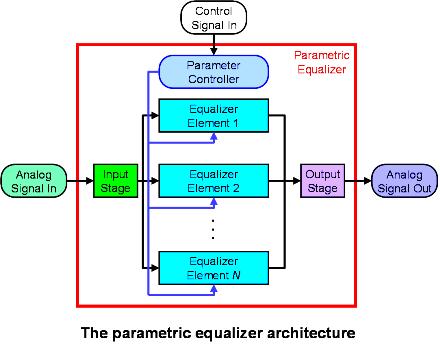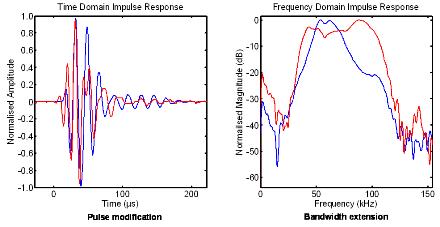Parametric Equalizer
Real-time parametric equalizer
The Ultrasonics Research Group in University College Cork has developed a real-time parametric equalizer for ultrasonic applications.
The parametric equalizer may be used to manipulate the response of an ultrasonic transducer system so that a desired response is tracked in real time. Undesired transducer resonances may be suppressed, bandwith may be extended by reinforcing frequencies at the upper and lower limits of the transducer response, and ripple in the transducer frequency passband may be removed.
Potential applications:
- automatic compensation for minor variations in transducer manufacture, e.g. element thickness, to produce an identical response from nominally similar transducers, allowing the use of cheaper devices or less stringent manufacturing processes. If a transducer or array element is replaced in a system, the equalizer will automatically re-calibrate the transducer's output to maintain a constant system response.
- automatic compensation for variations in output caused by transducer degradation over time, including independent adjustment of individual elements in an array.
- adaptive focusing of phased arrays.
- real-time noise cancellation or suppression.
- automatic real-time compensation for variations in propagation path properties, e.g. frequency dependent attenuation caused by an increase in path length or level of contamination.
The equalizer architecture
The technology architecture consists of N multiple equalizer elements arranged in parallel, with each element containing an oscillator-controlled, switched-capacitor bi-quadratic filter circuit. The parameters of each equalizer may be controlled in real time using an Adaptive Neural Network (ANN) included in the parameter selection circuitry. Additional output stage circuitry based on a sliding-rail Antoniou equivalent inductor circuit permits a high bias voltage to be applied to the output transducer, allowing the entire technology to be implemented in CMOS/BiCMOS and combined in a single package with an appropriate micromachined ultrasonic transducer (MUT).

Example: impulse response modification
In the example below, a parallel 2-element parametric equalizer was used to modify the impulse response of a capacitive ultrasonic transducer by extending the available bandwidth. The pulse duration and ringing has been reduced, with a corresponding increase in the available frequency passband. Using a parametric equalizer with N-elements would give even greater control and flexibility.

Real time parameter tracking
The use of multiple parallel equalizer elements is extremely difficult, due to the large number of often conflicting parameters that must be selected. Choosing parameters to improve the frequency response may then, for example, simultaneously degrade the time domain response. Many parameters are indirectly coupled to each other, so the controller developed in UCC uses an adaptive neural network to select an optimized set of parameters to track the desired output in real time. The plot below shows how the 2-element parallel equalizer tracked the gain, Q factor and center frequency of the output in real time. Again, using a higher number of parallel equalizer elements will produce even closer tracking.
![]()
Development status:
A working prototype consisting of two parallel equalizer elements has been implemented on a PSOC (Programmable System On Chip) platform, using an independent neural network to update the switched capacitor equalizer parameters to track a desired output in real time. Experimental verification of the technology was achieved using commercially available 50kHz capacitive ultrasonic transducers. The frequency capabilities of the equalizer were determined by the capabilities of the switched-capacitor elements available on the enabling platform.
Commercial Status:
UCC are currently seeking licensees for the technology.
Intellectual Property:
European Patent application number EP08105496.7, and provisional US Patent Application number 61/102,946 initial filing date 30 th October 2008, PCT stage filed.
Relevent Publications:
- Real Time Adaptive Parametric Equalization of Ultrasonic Transducers S.G. McSweeney and W.M.D. Wright, Proc. IEEE International Ultrasonics Symposium, Rome, Italy, 20-23 September 2009 (in press)
